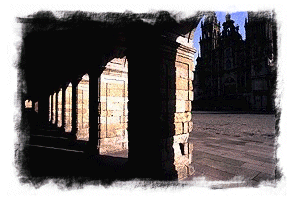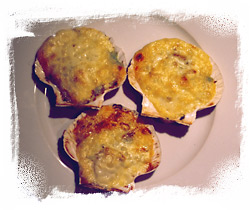
Santiago





Cambados


"Medeval"
Pontevedra



Oseira

Baiona


Santa Tegra



Galicia
Misty, Celtic Galicia in northern "green Spain". A million miles from the stereotypical Spain of flamenco and sangria.(here you find bagpipes and aguardiente) Visit Santiago de la Compostela
If you are feeling extravagent, stay at the parador.
Galicia's rias (fjords) are farmed to produce its masses of seafood. Maize and grelos are grown in small fields and stone "horreos" (grain stores)
Cambados
Gallego
Note that
many Gallego words vary from Castillian and that "x" should be pronounced
"sh", so Rias Baixas, "Rias Ba-has" in Castilian becomes "Rias Bay-shas",
double "rr's" are pronounced with a pronounced rolled "r").
![]()
Empanada
- olive oil pastry pies with a filling of sweet peppers and tuna or meat.
Caldo Gallego
- broth of haricot beans, grelos, paprika, potato and pork.
Lacon con
Grelos - slow cooked boiled ham, potatoes, chorizos and grelos.
Pimientos
de Padron - fried small green peppers, some hot !
Pulpo a la
Gallego - octopus stalls can be seen on many street corners.
Queimada
- grapa punch made from aguardiente (orujo)
Tarta de
Santiago - almond tart decorated with the cross of St.James.
Tetilla -
creamy cows milk cheese, in the shape of , well, a tetilla !
Vieras con
Jamon - scallops on the shell with ham
Albariño
white wine from the Rias Baixas denomination.
Ribiera de
Sacra is a recent DO, its vineyards often on steep slopes above the gorge
of the Sil, so steep that sometimes fixed steel ladders are set in place
to access the vines. Named "Sacra" as many of the vineyards were or are
owned by monasteries.
Grelos
is the typical green vegetable of Galicia, looking rather like a Brussels
sprout without the sprouts, the upper leaves being eaten. The usual english
translation is "turnip tops".![]()
![]()
A
classic empanada
Olive oil
short crust pastry made with either a little dry sherry or anis.
The filling.
Saute a chopped
onion in olive oil until soft.
Add the drained,
sliced red (bell) peppers from a jar or roast two peppers in the oven,
then peel and de-seed.
Add a few
strands of saffron.
Add the drained
contents of a tin of tuna or simmer 400 grams of fresh tuna in water until
cooked.
Line a flan
dish with pastry, add the fillings and cover with another layer of pastry
with a hole at the centre for steam to escape. Glaze with egg and bake
in a medium oven until golden brown.
A "modern
european" dish using Galician ingredients
Scallops
gratin with leeks.
 Open
and clean the scallops, removing the stomach (black) and the outer "frills".
Sever the scallop from the lower curved half shell but leave in place.
Open
and clean the scallops, removing the stomach (black) and the outer "frills".
Sever the scallop from the lower curved half shell but leave in place.
Season with
white pepper.
Blanch one
leek per 4 scallops until soft. Drain and chop finely.
Sprinkle
the leek evenly round the scallop and moisten with a trickle of Albariño
wine.
Cover with
thinly sliced tetilla.
Grill until
brown and eat with the remaining Albariño.
The scallop,
being sealed in by the cheese, retains its full flavour, complemented,
of course, by the soft Galician wine.You can use a little mashed potato
to anchor the scallops to the plate (we keep some "Smash" handy for the
purpose).
 Coquille
St Jaques
Coquille
St Jaques
The French call the scallop "coquille St Jaques" and the Spanish "concha de peregrino" referring to the identification of the scallop with the pilgrimage to Santiago (St.James). Pilgrims wear a scallop shell round thier necks and the shell motif can be seen on many buildings. The pilgimage has now become very popular with a constant stream arriving at Santiago.
See also
:-
CheeseWineSpanish
cookery books Cookery
reference books
Walking
in Spain | Walking in
Britain | Spanish
photos | Spanish
pronunciation & general guidebooks | Andalucia
|
Asturias
| Basque Country
|
Canary
Islands | Castile
Catalonia
& Balearics | Extremadura
| Galicia
|
Navarre
| Valencia | Tapas
|
Glossary
|
Books